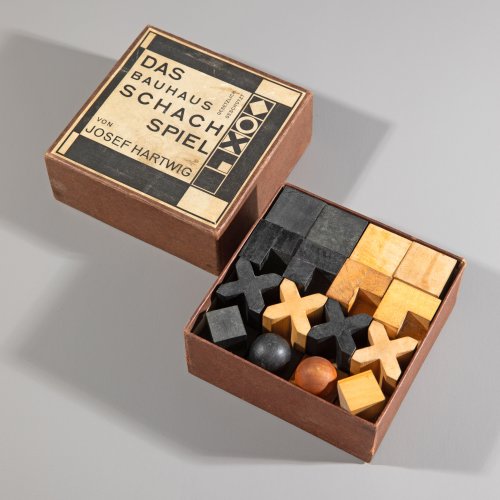Biography
Josef Hartwig, born in Munich in 1880, is a sculptor who belonged to the generation of teachers at the Weimar Bauhaus. His strict, functional concept of art is rooted in an era of great joy in jewelry: Art Nouveau. At the age of thirteen, Josef Hartwig began an apprenticeship with the sculptor Simon Korn. In his studio, which cultivates a historicizing, eclectic style, architectural projects are also prepared in plaster models on behalf of the building department. In this context, the young Josef Hartwig came into contact with such famous architects as Theodor Fischer. A second well-known master builder was to give Josef Hartwig an early and brilliant major work: in 1897 August Endell entered the studio with a pencil drawing of an ornamentally abstract dragon that was to adorn the famous Art Nouveau façade of the "Photoatelier Elvira" in Munich. The task of transferring this idea from a sketch to the wall and transforming it into a three-dimensional structure fell to 17-year-old Josef Hartwig, who received many suggestions from Endell in the course of this work. The masterpiece survives only in photographs today. From 1904 to 1906, Josef Hartwig studied sculpture at the Munich Art Academy under Balthasar Schmidt, which he financed by working as a sculptor. He also studies architecture, drawing and art history as minor subjects at the academy. The death of his parents in 1906 was a deep turning point in Josef Hartwig's life. Restless years in different cities follow. In 1910 Josef Hartwig settled in Berlin. There he was to work as a sculptor for eleven years, interrupted by the war he hated, until Walter Gropius appointed him head of the workshop for wood and stone sculpture at the Weimar Bauhaus in 1921. In this context, for example, Josef Hartwig created wall sculptures together with Oskar Schlemmer based on the latter's abstract, figurative designs. These works in the staircase of the workshop building were removed in 1928 by the Weimar Bauhochschule as "superfluous ornament". One of the best-known Bauhaus works by Josef Hartwig is the reduced, geometrically additive "Bauhaus Chess Set", which is now in such famous collections as that of the Museum of Modern Art in New York. From 1925, i.e. since the Bauhaus moved to Dessau, Josef Hartwig worked as a teacher for sculpture, geometry, perspective and writing at the art academy in Frankfurt, the Städelschule. During this and the following years, Hartwig worked together with important artists such as Gerhard Marcks, Georg Kolbe, Toni Stadler and Richard Scheibe, and also created numerous independent sculptural works. Mention should be made, for example, of figures for a marionette theater or a harmoniously abstracted owl made of red Veronese marble. His Bauhaus colleague Gerhard Marcks created a bronze monument to the powerful, creative art of Josef Hartwig by elevating "Hartwig's chiseling hand" to the subject of one of his sculptures. In addition to creating his own sculpture, Josef Hartwig also worked on restoration: from 1938 until the end of the war he worked as a restorer at the Städtische Galerie in Frankfurt, and after 1945 as a master craftsman in the restorer's workshop of the sculpture collection in Frankfurt's Liebighaus. Josef Hartwig died in Frankfurt in 1956 at the age of 76.

